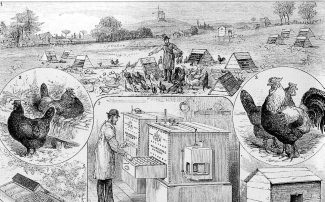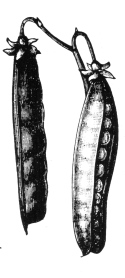Country Captain a plainer way.
Jane Grigson ascribes this minimalist version to London, but we have no idea why she found a connection to the capital. Country Captain once was prevalent throughout Britain; complicated versions involving fruit like apples, bananas and raisins are still cooked today in the coastal south of the United States, and it does have deep connections to both Charleston and Savannah. People in each city maintain (mistakenly) that the dish originated there rather than in India or Britain.
Here is Mrs. Grigson’s version of an origin myth for Country Captain, similar in substance to David Burton’s:
“The intriguing name comes from the English habit when in India of referring to anything Indian as ‘country’ (in contrast, often unflattering contrast, to ‘European’ or, in the case of horses, ‘Arab’). Country captains were in charge of country ships, and a simple dish often served onboard of spiced kid, veal or chicken with onions was called Country Captain, too: it was well known by 1825, and like kedgeree was brought back as part of the diet they had grown used to by returning members of the Raj.” (The Observer Guide to British Cookery, London 1984, 50)
Mrs. Grigson’s recipe goes something like this.
 - 4 Tablespoons unsalted butter
- 4 Tablespoons unsalted butter
- 4 Tablespoons neutral oil
- about 4 cups thinly sliced onions
- ½ heaped teaspoon cayenne
- 2 teaspoons salt
- 1 teaspoon turmeric
- 12 chicken thighs, skinned, or other chicken pieces of similar size (quartered breasts, legs, biggish wings)
- about a cup of chopped cilantro (both stems and leaves)
- Heat the first batch of butter and oil in a large heavy skillet over medium to high heat and stir in the onions. Fry them until they turn deep gold.
- Remove the onions with a slotted spoon, spread them on a baking sheet, salt them if you like, and put them in the oven to darken and crisp while you cook the chicken pieces. The timing is hard to predict so monitor them. Do not wash the skillet.
- Combine the cayenne, salt and turmeric in the onions’ skillet over very low heat and stir-fry them for only just 2 minutes, then add the chicken pieces to the pan, coat them evenly with the butter and oil, raise the heat to medium and fry the chicken until cooked through.
- Serve the chicken with tongs or a large fork so that it does not drip fat, and top it with nests of onion from the oven.
- Sprinkle generously with cilantro and serve.
Notes:
- The trick here is to cook the chicken through to the bone without burning the surface or allowing it to stick in shards to your skillet. A nonstick or lovingly seasoned cast iron skillet really helps this dish. You will need to tinker with the level of heat so that the meat turns out, as our Curmudgeonly Racounteur describes perfectly pink calves liver, “just just.”
- Mrs. Grigson advises us to serve this Country Captain with basmati rice, and peas (separate; not mixed. This is British food.) “and side dishes.” During the nineteenth century, sides to British curries included crumbled bacon, shredded coconut, Bombay duck (a pungent preserved pressed fish product), chopped nuts, chutneys and the like.
- Patricia Brown offers a similar and simpler recipe in Anglo-Indian Food and Customs (New Delhi 1998). Like the Poynter recipe from 1904, Brown’s Country Captain omits cayenne to rely on black pepper and green chili for its heat: The typically Indian ghee (basically clarified butter) stands in for butter. Brown omits the lemon juice too, and uses water rather than the stock appearing in the bfia recipe. She serves fried sliced potatoes with her Country Captain; they would not be as good in the company of citrus.
- Brown adds that “Country Captain is excellent when accompanied by a side dish of cabbage or cauliflower foogath.” (Anglo-Indian Cookery 120) Once we figured out the meaning of ‘foogath,’ we concurred with her judgment. It is, logically enough, an Anglo-Indian term: Brown explains that “[a]n apt description of the foogath would be, a delicately spiced stir-fry of vegetables made with oil, onions, mustard seeds, ginger and garlic.” (Anglo-Indian Cookery 274)
- To make a cabbage foogath, pour about 1/3 cup of ‘cooking oil’ into a heavy skillet and cook a teaspoon of mustard seeds until they pop. Add 4 or 5 onions sliced into thin crescents and two Serrano chilis, seeded and sliced lengthwise into eighths; cook until the onion turns golden. Add 2 teaspoons of minced ginger and 1 of garlic, cook for about a minute until they begin to smell good and then add handfuls of a shredded medium cabbage to the skillet until all of the cabbage is “crisp and tender” and garnish the foogath with at least a generous Tablespoon of shredded coconut. This is a rich recipe but a good one, adapted from page 280 of Brown’s Anglo-Indian Cookery.
- Brown does not specify a type of oil (or a particular chili for that matter) to use in making her cabbage foogath, but we like a mixture of 2/3 neutral oil, like canola or corn, and 1/3 mustard oil, an ingredient unjustifiably neglected in western kitchens. We also prefer Savoy cabbage, which probably is mildly inauthentic. We do not care.
 - Madhur Jaffrey does something similar, but a little lighter, with cabbage and peas. The preparation is a staple with both Indian and western dinners in the household of the Editor. The bfia version of the Jaffrey recipe increases the seasonings substantially. Shred half a head of Savoy cabbage and defrost about a cupful of good small peas, then leave about 3 Tablespoons of canola oil, or, better, a Tablespoon of mustard oil and 2 of the canola, into a heavy skillet on medium high heat until it shimmers. Add 2 teaspoons of whole cumin seeds and two bay leaves to the pan; once they color and smell good, add the cabbage and peas and toss to coat them with the oil[s]. Stir ¼ teaspoon of cayenne, ½ teaspoon of turmeric, a minced green chili, a scant teaspoon of sugar and some salt into the cabbage mixture, cover the pot, reduce the heat to low and cook the dish until the cabbage is as crunchy or tender as you like; it will not take long. Stir a teaspoon of gram masala into the vegetables and you are ready to go. Powdered cumin will work in a pinch.
- Madhur Jaffrey does something similar, but a little lighter, with cabbage and peas. The preparation is a staple with both Indian and western dinners in the household of the Editor. The bfia version of the Jaffrey recipe increases the seasonings substantially. Shred half a head of Savoy cabbage and defrost about a cupful of good small peas, then leave about 3 Tablespoons of canola oil, or, better, a Tablespoon of mustard oil and 2 of the canola, into a heavy skillet on medium high heat until it shimmers. Add 2 teaspoons of whole cumin seeds and two bay leaves to the pan; once they color and smell good, add the cabbage and peas and toss to coat them with the oil[s]. Stir ¼ teaspoon of cayenne, ½ teaspoon of turmeric, a minced green chili, a scant teaspoon of sugar and some salt into the cabbage mixture, cover the pot, reduce the heat to low and cook the dish until the cabbage is as crunchy or tender as you like; it will not take long. Stir a teaspoon of gram masala into the vegetables and you are ready to go. Powdered cumin will work in a pinch.
The original recipe appears in Madhur Jaffrey’s Indian Cookery. (London 2002)
- A knowledgeable friend of the Editor, who operates a cozy restaurant in northern Vermont and cooks Gujarati dishes at home, has commented that Jaffrey’s is not particularly authentic regional Indian food, and he is right. She is too cosmopolitan in outlook and experience not to incorporate influences as disparate as the Raj, Singapore and Britain. That fact, however, only enhances the appeal of her work.
- Brown’s cauliflower foogath adds cumin seeds, curry leaves and a chopped tomato to the base of foogath seasonings. She heats ¼ cup of oil over medium heat, throws a teaspoonful each of whole cumin and mustard seeds along with some curry leaves into the skillet until the seeds pop, fries a single sliced onion golden, then lowers the heat before adding two minced chilis, two teaspoons of minced ginger and one of minced garlic. The tomato follows the aromatics into the pot along with a cauliflower that Brown has separated into flowerets and parboiled. The foogath simmers under cover until the cauliflower is just tender, for about ten minutes. Then she checks for salt and serves the dish hot. (See Anglo-Indian Food 280-81)
- Back on the plainer Captain front, yet another minimalist version appears in Dr. Riddell’s Indian Domestic Economy and Receipt Book, a Calcutta imprint from 1849:
“Cut a fowl in pieces; shred an onion small and fry it brown in butter; sprinkle the fowl with fine salt and curry powder and fry it brown; then put it into a stewpan with a pint of soup; stew it slowly down to a half and serve it with rice.”
This is the earliest published recipe for Country Captain that we have encountered. Modern recipe writers could do worse than aspire to its economy and clarity of style. The reference to ‘soup’ of course means chicken stock.

